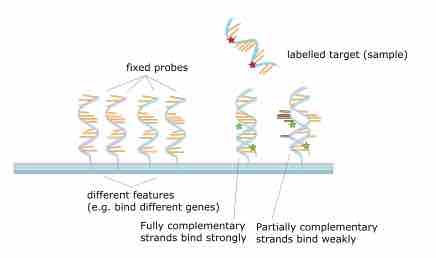The Transcriptome
The transcriptome is the set of all RNA molecules, including mRNA, rRNA, tRNA, and other non-coding RNA produced in one or a population of cells. The term can be applied to the total set of transcripts in a given organism, or to the specific subset of transcripts present in a particular cell type. Unlike the genome, which is roughly fixed for a given cell line (excluding mutations), the transcriptome can vary with external environmental conditions. Because it includes all mRNA transcripts in the cell, the transcriptome reflects the genes that are being actively expressed at any given time, with the exception of mRNA degradation phenomena such as transcriptional attenuation.
Analysis of the Transcriptome
The study of transcriptomics, also referred to as expression profiling, examines the expression level of mRNAs in a given cell population, often using high-throughput techniques based on DNA microarray technology. A number of organism-specific transcriptome databases have been constructed and annotated to aid in the identification of genes that are differentially expressed in distinct cell populations.
DNA microarrays can provide a genome-wide method for comparison of the abundance of DNAs in the same samples.The DNA in spots can only be PCR products specific for individual genes. A DNA copy of RNA is made using the enzyme reverse transcriptase. Sequencing is now being used instead of gene arrays to quantify DNA levels, at least semi-quantitatively.
The transcriptomes of stem cells and cancer cells are of particular interest to researchers who seek to understand the processes of cellular differentiation and carcinogenesis. Analysis of the transcriptomes of human oocytes and embryos is used to understand the molecular mechanisms and signaling pathways controlling early embryonic development, and could theoretically be a powerful tool in making proper embryo selection during in vitro fertilization.

DNA microarray principle
The core principle behind microarrays is hybridization between two DNA strands, the property of complementary nucleic acid sequences to specifically pair with each other by forming hydrogen bonds between complementary nucleotide base pairs.